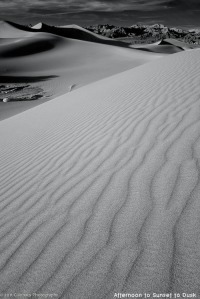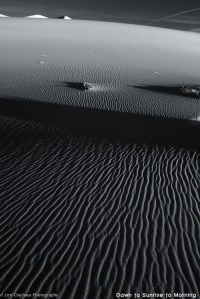It was 27 years ago that I had last traveled to Racetrack Valley.?? It was a bit rougher in those days: no GPS, no mobile phones, little in the way of signage, only topo maps and your own innate sense of direction (or not).?? We – my wife, our 9-year daughter, and our first golden retriever (Whiskey) – drove in through the northern ‘backdoor’ of Eureka Valley – not yet part of Death Valley National Park (in fact, the park was not yet a park, merely a monument) – via my old rattle-trap of a ’72 International Scout.?? That vehicle had a lot of character and the temperament to match.?? It could drive over anything…or break down trying.?? After a day and night of camping and climbing the Eureka Dunes we continued south past Ubehebe Crater and onto the Racetrack Valley road: 28 miles of mean washboard.
Back then, at the aptly named Teakettle Junction (mile marker 19), we took a detour on the Hunter Mountain Road, where we spent a night in the Cottonwood Mountains with a glorious view of Death Valley, before backtracking the next day to Racetrack Valley.?? Maybe I was just used to bumping along on stiff suspension back in those days, but I have no memories – negative or otherwise – of the Racetrack Valley Road being anything more than long. (Now, the Lippincott Mine Road is another story entirely, though one I’ll leave unsaid for now.) This time it really was a painful 3 hours of bumping and rattling and shimmying along.
But first, we made the mistake of asking at Park HQ in Furnace Creek how the road was.?? I proceeded to get the 3rd degree from a young ranger: What kind of tires do you have? How many plys are they??? What kind of vehicle are you driving? How many spares do you have? Etc. And then she started laying down the fear-factor: it’s a terrible road; lots of flat tires; big sharp rocks; you’re on your own; no tow service, ad nauseum.?? The road was rocky (small, not big rocks and they didn’t seem particularly sharp either) and washboarded, but beyond that her hyperbole does the Park Service a disservice.?? I understand that they have to deal with lots of boneheads who get themselves into stupid predicaments, but by deliberately inflating the risk of venturing out, they feed into the misguided mantra that the National Park system (read: the federal government) is just trying to “lock up the land.”
We also made the mistake of filling up at Furnace Creek: >$5/gallon!?? But, really, that and Stovepipe Wells are your only two choices for fresh petrol in the Park.?? (The latter is about a dollar cheaper so if you can, fill up there.)?? As we drove north, the air was still quite hazy from over 24 hours of high winds. Why hazy??? The winds created a sandstorm in the Mesquite Flats area that basically completely blotted out Stovepipe Wells Village and the upper Death Valley basin for the better part of a day.?? When you want clean sand dunes with little to no tracks, post storm is the time to wander in the dunes.
If you venture this will you leave the pavement at Ubehebe Crater. But, before you do so, check out the crater and surrounding ash lands left over from what appear to be a dramatic series of eruptions some 2,000-7,000 years ago.?? A nice hour-plus long walk around the rim of the ?? mile wide, 777 feet deep crater is just what you need before the grind on Racetrack Valley Road.????
Slowly we climbed the long alluvial fan to the high point of Tin Pass (4990’).?? This area is rich with Joshua Trees and if the light is right and you can afford the time, a break here to photograph the weirdly twisted and faintly anthropomorphic plants is a welcome reward.
A little less than an hour later and we arrive at Teakettle Junction.?? Legend states that over a hundred years ago a miner placed a teakettle at this fork in the bad road. Tradition has lead to hundreds of people doing the same over the last century.?? When I was last here there were but a few.?? Now? Perhaps 50.
In the distance, some 6 miles away, gleamed Racetrack Valley while just beyond reared the dark southern extremity of the Last Chance Range. This was all familiar to me now: like returning to a well-loved place after many years. Which, it is.
Next Post: Grandstanding and Moving Rocks

























